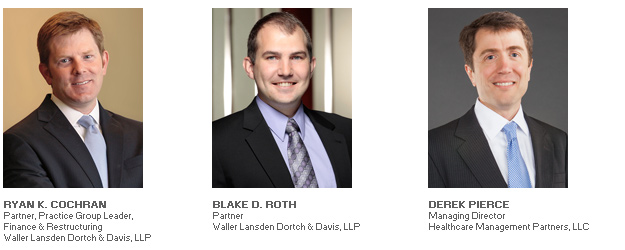
It goes without saying that a lender must work to maximize its recovery when a borrower is in default and has no reasonably realistic or meaningful way to cure the default.
This scenario far too often forces a lender to determine the most efficient and effective method to sell its collateral. As part of that decision-making process, a lender must consider how any course of action will serve to protect the lender from allegations and perceptions (i) of self-dealing or favoritism in the selection of the buyer, (ii) of under-valuing the collateral, (iii) that the collateral was not effectively marketed, (iv) the lender sold the collateral for too little, or (v) the lender sold the collateral through a secretive process. In this article, the authors address these issues and discuss:
- Why some methods of liquidating collateral are superior to others;
- How a chosen method for liquidating collateral can protect a lender; and
- What a lender can do to establish an effective process to liquidate its collateral.
Generally speaking, the easiest way to monetize collateral is by sale, and there are two primary methods of liquidating by sale—private sales and public sales (e.g., an auction). Private sales are characterized by direct negotiations of terms between the buyer and lender or the lender’s representatives. In contrast, a public sale involves exposure of the collateral to the market and competitive bidding amongst parties, with the collateral being sold to the highest or otherwise best bidder. In many instances, a public sale process is preferable to a private sale. For example, when the price is uncertain a public sale may be used effectively to set the market price rather than the lender or its representatives having to determine the price.¹ Further, when more than one purchaser has interest in the collateral, a lender or its representatives can allow the public sale to efficiently select the purchaser. In such a scenario, the public aspect of a public sale adds an element of transparency to the process, permits interested parties to participate in the bidding, and lessens any potential appearance or allegation of impropriety in the selection of the successful bidder.²
With public sales, the method of sale may take several forms: (i) an absolute or no-reserve auction where the collateral will be sold to the highest or best bidder regardless of price; (ii) a limited reserve auction where the collateral will be sold for the highest bid, but only if such bid exceeds a predetermined minimum amount; or (iii) stalking horse auctions, where a purchaser—the “stalking horse purchaser”—enters into a binding agreement to purchase the collateral and subsequently subjects the agreement to the market through an auction. Amongst the different types of auctions, a stalking horse auction is often most effective, because:
The initial selection of a stalking horse purchaser effectively permits a lender to set a reserve price:
- Once selected, the stalking horse purchaser establishes a floor for monetizing the collateral, ensuring the presence of at least one participant prior to incurring further expenses promoting an auction process;
- A stalking horse auction permits the lender to market-test the stalking horse purchaser’s offer, effectively defining the market and determining whether higher and better offers could be obtained, thereby protecting against allegations that the collateral was not effectively marketed;
- The collateral is exposed to a competitive bidding process with all interested parties afforded an opportunity to participate, thereby protecting against allegations of self-dealing or favoritism on the part of the lender;
- The overall competitive process, the process is open to interested parties, protects the lender from allegations that, among other things, the price obtained for the collateral was not adequate.
So, with all these benefits, one may ask: How exactly does the stalking horse process work?
Earlier this year the authors conducted a unique stalking horse auction.³ In an ongoing proceeding, the Securities and Exchange Commission sought and obtained the appointment of Derek Pierce, one of this article’s authors, as a receiver over nine separate assisted living facilities. In his role as receiver, Pierce determined the facilities would be best marketed for sale in one stalking horse auction. Each of the nine assisted living facilities had a separate secured lender with a lien on substantially all the facility’s assets. At the receiver’s request, the receivership court:
- approved the engagement of a broker to assist in marketing the facilities,
- approved stalking horse purchasers,
- established bidding procedures,
- established a timeline for the receiver to market-test the stalking horse purchasers’ bids and to qualify additional bidders,
- established a timeline to conduct an auction, and
- held a hearing to confirm the successful bidders and approve the sales.
Eight of the nine facilities had two qualified bidders. The facilities were located in two different states, and the receivership court was in a third state. The initial stalking horse bids totaled $23,925,000. The successful bid amounts obtained at the stalking horse auction were $27,115,000 resulting in an increase in real cash consideration from the auction of $2,714,000.(4)
Best practices are always being fine-tuned, but several emerged from the process.
Best Practices for Conducting a Stalking Horse Auction
A stalking horse auction has the best chance for success when the assets being auctioned are highly sought after by multiple parties. The second-best chance for success involves a well-planned process. The authors divide the process into seven segments:
- preparation,
- marketing,
- negotiation,
- court-approval,
- market-testing,
- auction, and
- closing.
Preparation
Take time to prepare before you commence the stalking horse process. Identify whether improvements can be made to collateral that will increase its value at a sale. If the improvements are feasible, consider making the improvements before taking the collateral to market. Be able to demonstrate what you are selling. If the assets include real estate, perform a title search and order a title commitment. Potential buyers can then see the insurable title they can obtain. Determine whether a broker or investment banker will be engaged. Gather items you believe potential purchasers will want to review and establish a due diligence data-room. Create a confidentiality agreement for interested parties to execute so they can conduct due diligence. Draft a purchase agreement for potential interested bidders to review and comment upon.
Marketing
Create an offering memorandum describing the assets to be sold. Create a contact list of potential buyers. The list can include all known industry participants. In the case of a senior living facility, you might identify as many of the owners and operators locally, regionally, and nationally of assisted living facilities, skilled nursing homes, and memory care facilities. You might also include in your contact list any brokers, accountants, attorneys, or investors that you have identified as active in the senior living industry who may have clients with an interest in the collateral. Keep track of all the parties you have contacted, all the parties you send confidentiality agreements to, all the parties who execute a confidentiality agreement, all the parties who tour or conduct any due diligence, and all the parties who submit a bid. This evidence can support your marketing efforts.
Negotiation
Determine the best candidate to serve as the stalking horse purchaser. Execute an asset purchase agreement with the stalking horse purchaser that is subject to any higher and better offers. Determine whether the stalking horse purchaser will be entitled to bid protections and the extent of those bid protections. Bid protections may include a break-up fee. A break-up fee is money paid to the stalking horse purchaser if it is not the successful bidder in consideration for the stalking horse purchaser’s agreement to expose its initial bid to an auction. Bid protections can also include a minimum overbid and established bidding increments. A minimum overbid is a pre-determined dollar amount by which the first bid must exceed the stalking horse purchaser’s initial bid.
Court-Approval
Seek and obtain court-approval of procedures for soliciting additional bids, the manner and method of notice of the stalking horse auction’s bidding procedures and sale, the date on which the stalking auction will occur, and the location at which the stalking horse auction would occur. Finally, request that the court establish a process to confirm the results of the auction.
Market-Testing
To market-test the proposed stalking horse purchaser’s initial bid, the bidding procedures should provide prospective purchasers a reasonable timeframe within which they may perform due diligence, qualify to bid, and decide to attend the stalking horse auction.
Market-test the stalking horse purchaser’s bid by sharing it with your contact list. Solicit additional bids. Qualify additional bidders.
Auction
The risk of favoritism or bias in the selection of the buyer is mitigated with a public auction, and a competitive bidding process confirms the adequacy of the price obtained. The stalking horse auction features:
- Public process to identify qualified bidders.
- Qualified bidders submit bids and counter bids.
- Successful bidder is selected at auction. Back-up bidder is often identified.
- Auction memorialized and reported to the court.
- Court approves successful bidder and back-up bidder.
Closing
Follow the process established by the court to confirm the auction results. Once the court has confirmed the results of the auction, proceed to a closing of the sale. In a regulated business - permit time for obtaining regulatory approvals before the closing. Maintain funds necessary to protect the collateral until the closing can occur.
Conclusion
If the process is followed, the stalking horse auction gives the seller a better chance of selling its assets at a fair market value than any other process, while reducing the seller’s exposure to criticism and second guessing. As we experienced in executing the successful sale of nine assisted living facilities earlier this year in a single stalking horse auction, the process also has the potential to create additional value for lenders.
____________________________
1 E.g., Pereira v. WWRD US, LLC (In re Waterford Wedgwood USA, Inc.), 500 B.R. 371, 381 (Bankr. S.D.N.Y. 2013) (“fair market value is equivalent to the winning bid accepted at an auction”); Washington v. Cnty. of King William (In re Washington), 232 B.R. 340, 345 (Bankr. E.D. Va. 1999) (stating the general rule is where judicial sale is duly advertised and fairly conducted, the winning price will not be disturbed absent evidence the price offered is grossly inadequate). But see Schwartz v. Cuyahoga Cnty. Bd. of Revision, 39 N.E.3d 1223 (Ohio 2015) (citing state statute that provides the price from an auction or forced sale is presumptively not evidence of a property’s value, absent proof that the transaction occurred at arm’s-length between typically motivated parties).
2 In addition, in federal receivership proceedings, an auction process permits you to avoid the costs of complying with the appraisal requirements for a private sale. See 28 U.S.C. § 2001(b) (requiring three appraisers for private sale of property).
3 A private sale or public sale can be conducted outside of a court proceeding. However, stalking horse auctions are most common in bankruptcy proceedings or receivership proceedings. In such cases, seeking and obtaining court approval of the stalking horse auction process, including giving notice to all parties with an interest in the collateral, will almost always be required and can strengthen the propriety of the stalking horse auction process. The best practices described herein assume that the sale process will be conducted in a court proceeding.
4 Read Healthcare Management Partners’ press release on the sale of the facilities.
